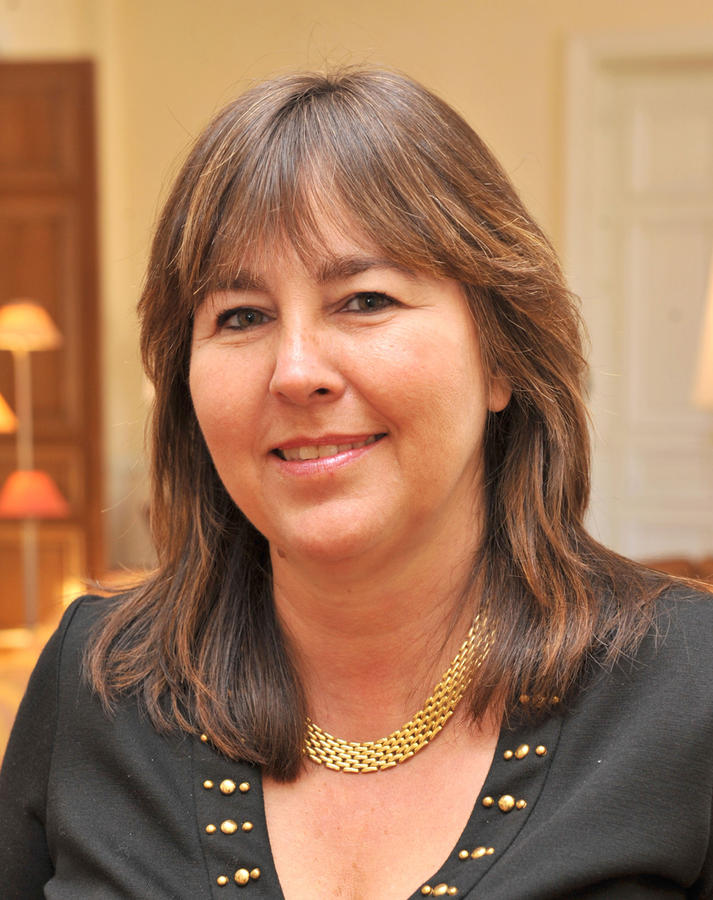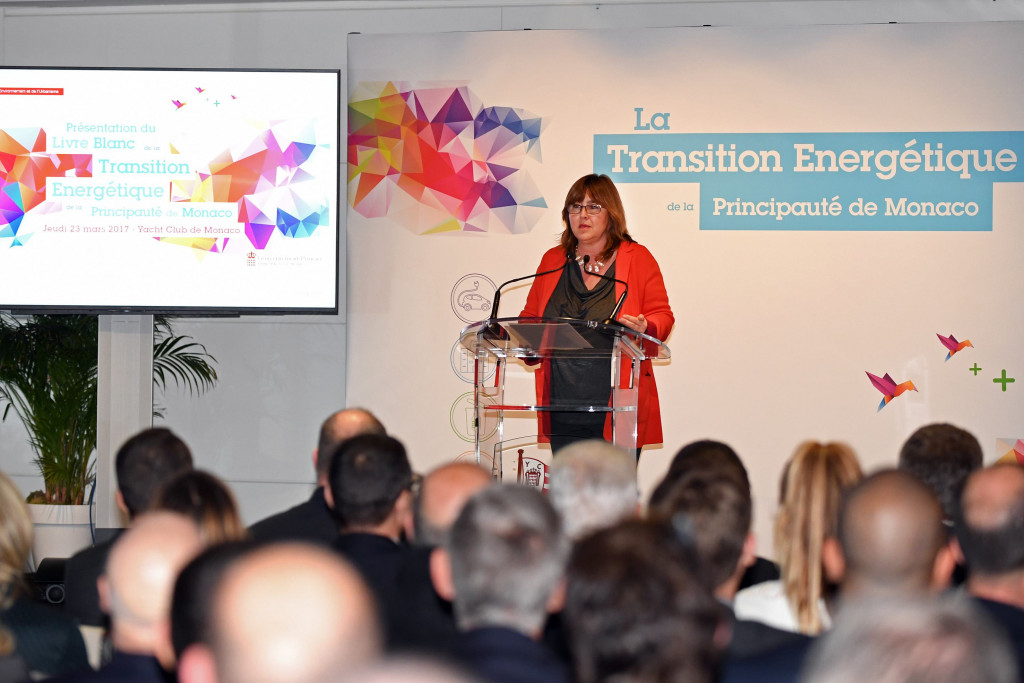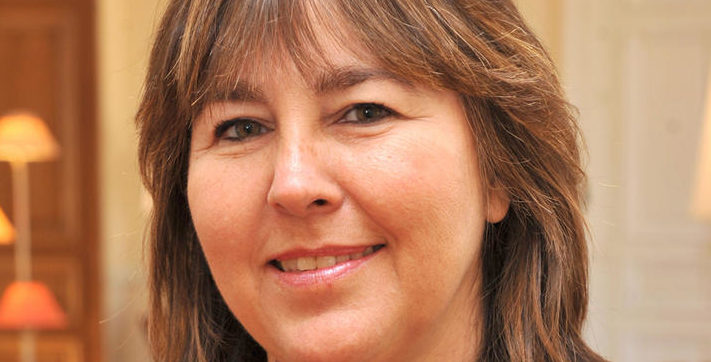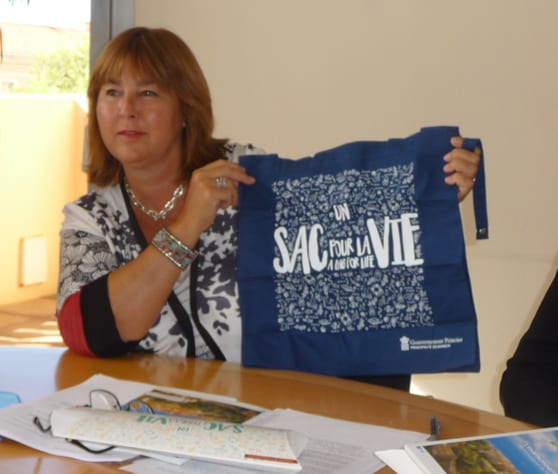
Minister Gramaglia has just presented “Le Livre Blanc” (The White Paper) on “The Transition of Energy of the Principality of Monaco” at the Yacht Club, along with Jean-Luc Nguyen, Director of the Mission for Energy Transition, and in the presence of Prince Albert, who said, “Be assured of my determination that our community will evolve in a progressive but irreversible way towards this energetic transition.”
Energy transition is only a part of Minister Gramaglia’s current Ministry of Public Works, the Environment and Urban Development, of which, not counting postal, there are 10 services, including public works, that covers all major construction projects and of course, the environment, an important commitment of Prince Albert both on a global level as well as for his own country. Other services can be more technical, like electronic communication, or extremely diverse, such as the ports and civil aviation with the heliports, that deal with all the concessions of Monaco, maintenance of the roads and the public gardens.
“The Ministry and its departments have a direct impact of the daily lives of many people,” the Minister explained, “and I try my hardest to get involved in all these domains. I have a great team – there are 10 heads of service with some 700 people working in the Ministry.”
A legal background that could be applied to all disciplines
Yet her path to her Minister position is rather extraordinary. Minister Gramaglia studied law, stating that when was young she wanted to work in the legal domain, but not necessarily as a lawyer or a notary. “Even though I spent six years working as a notary in France, this was more to give myself a legal background that could be applied to all disciplines. That way, I told myself, I could do any profession.”
Born in Monaco and Monegasque, the Minister left home at 18 and “worked to pay my way through university, as I had no financial support from my parents”. She studied in Nice and Aix-en-Provence, putting herself through eight years of post-secondary education, which included, at times, working “all sorts of jobs”, such as selling bags in Old Nice or babysitting, to pay for her studies.
“On a personal level, this has given me a certain social awareness. Even though I wasn’t far from Monaco, I saw another way of life and when I returned to Monaco some ten years later, as a qualified notary, I had obviously had a whole range of experiences that I wouldn’t have had if I’d never left.”
The Minister, who cleverly assessed early on that “whenever we face a problem in life, we take either a lawyer or a notary, so a legal background equips us for many things,” said that indeed her legal background has enabled her to work in different domains within the Monaco administration – from the legal department to the electronic communication department, and from finance to economic development. “It was enriching, and I like change and working in many different fields.”
She was “very honoured” to be appointed by Prince Albert as Minister in 2011.
“I think that my legal training has given me this open-mindedness and enabled me to adapt to different situations,” she reflected. “For example, I don’t have a technical background, but I am able to analyse technical documentation, and can stand back and take a decision based on a range of skills, including a woman’s ‘good sense’ and a legal advisor’s vision, which is maybe more global than that of a technician, who has a more precise understanding of the subject.”
Two significant projects have been added recently to the Minister. First, under the direction by Mr Jean-Luc Nguyen, the sea urbanisation project is an attempt to “relieve the sclerosis of Monaco” and to increase its territory (more on this later).
A second project, Energy Transition, added last year, falls in accordance with the Prince’s environmental commitments, taken notably during COP21 in Paris in 2015, with an ambitious 50 percent reduction of greenhouse gas emissions by 2030 and to reach carbon neutrality by 2050. “Everything we are doing – in terms of environmental protection and alternative means of transport – must be multiplied by four in order to satisfy this commitment,” Minister Gramaglia said. “I have put together a dedicated team for the Energy Transition Project, and this, of course, is an addition to the Ministry’s regular workload.”

Tackling traffic and the environment
As elucidated by Minister Gramaglia, COP21 succeeded in mobilising several countries to sign a number of quite restrictive agreements and to commit to a certain process to slow down climate change, and to protect the oceans and the environment.
Due to his universally recognised commitment as head of state helping to save the planet, the Prince had a large presence at COP22, the Marrakesh Conference on Global Warming in November 2017, a continuation of the Paris agreement to incite countries to raise funds to contribute financially to international “green” funds to allow developed countries to help less developed countries to all move in the same direction.
The Minister does not just talk the green talk: “I drive an electric vehicle, I recycle my waste, I am far more aware of the importance of protecting the environment and I transmit this to my daughter, who then shares this with her friends.”
She continued, “We are, in my Ministry, obviously more aware of these issues and we work towards improving recycling, the cleanliness of the principality, alternative means of transport to reduce the number of cars on the streets and increase the use of electric vehicles, though grants, or the provision of free parking spaces for electric vehicles, or recharging stations.’
The Minister pointed out that the departments linked to her Ministry also works towards improving conditions for pedestrians in Monaco, with lifts, escalators, and stairs that make walking around easier. There is an increasingly efficient bus service that uses hybrid buses. All new construction projects automatically incorporate plans for lifts to facilitate access from one boulevard to another. Three lifts have been installed around the hospital, to enable the public to access the hospital from Charles III.
In front of the train station there is a tunnel under construction to access boulevard de Suisse. “Everything is done to make green transport in Monaco a priority.”
Discussing the success of initiatives to encourage people to use their car less, the Minister cites the electric bike. “There are around 100 electric bikes with 16 stations – with a new one to open soon and we’ll continue to add stations. We have 700 subscribers. This, of course, contributes to a reduction in car use. We distribute free bus cards for school children.”
There are two car park projects on the outskirts of the Principality, with the construction of the first one, with 1820 places situated near the Exotic Gardens, about to start. And a second 700-place car park is planned on the east side in Testimonio II urban project, which will be linked to Monaco’s public transport system accordingly.
There is also discussion about the possibility of building a cable car from the Exotic Gardens bd to Fontvieille, to encourage people to leave their cars on the outskirts of Monaco. “There are around 115,000 arrivals and departures by vehicles in and out of Monaco every day, with the entry to Monaco from the Exotic Gardens being the most used. What we want is to make people park their vehicle outside of Monaco, at an attractive rate, and less expensive than parking their car inside the Principality. This means that some the commuters that drive into Monaco could use this car park and access the centre via the cable car, resulting in less traffic and less pollution.”
While the Ministry of Public Works, the Environment and Urban Development has been working to improve traffic within Monaco, they are also looking to facilitate the accessibility of the Principality from outside, by train and by bus, which includes works to extend the platform at Nice Riquier train station to allow the use of longer trains, and so doubling the number of passengers per train, from around 900 to 1800. “This will encourage more people to take the train because there will be more places,” explained Minister Gramaglia. “And we will contribute financially to the works. We are currently in discussion to buy two new train carriages to be made available to the SNCF during the rush hours into and out of Monaco.”
Concerning the Cannes-Ventimiglia line, Monaco has contributed to studies and, to a certain extent, to the works to improve the line. “We are also working on the interconnectivity of buses and trains and between the different bus lines within Monaco,” she added. “The famous Carte Azur and Carte Zou bus and train passes, to allow holders to use the same card even when changing from one system to another. Also, the bus line 100 between Nice and Monaco has been optimised by introducing bigger buses.”
Achievements six years on
Minister Gramaglia declared that the public has shown a great willingness to reduce the number of cars and emissions by shifting to alternative and greener means of transport, such as bicycles or car-pooling.
Recycling is something the Ministry continues to work on, to encourage households to sort their waste. “We have named a number of ‘recycling ambassadors’ within the administration and the Department of the Environment has carried out a communication campaign about the importance of recycling and colour-coded recycling points have been set up around Monaco to make it easier for people to sort their waste.” Although residents first felt it was complicated, they are now used to the system.
Another issue is dog mess, but with bag distributers now located throughout Monaco, “We have seen a change in behaviour among dog owners, not all, but some, cleaning up after their dog”.
The distribution of plastic bags in Monaco shops has been forbidden since 2016, so the Department of the Environment worked with storeowners to adapt to this change, to support them and to find the best solutions to each individual’s problem.
In parallel, last fall every household was sent “Un Sac Pour la Vie” (A Bag for Life), which was a great success. “Whenever we have tried to have a close contact with the population of Monaco, we have had a positive reaction,” the Minister assured.
A fine example of this connection is the Energy Transition, for which the Ministry was in touch with some 60 people from various sectors in Monaco, such as health, tourism and construction, for example, to discuss their expectations from the government and to respond to questions about recycling and how to best share practices. “This again has been highly successful,” the Minister said before adding, “I believe that the involvement of the Prince and his commitment has done a lot to contribute to this success. Monaco is something of a shop window for the rest of the world and everyone wants to follow its lead.”
When the Ministry started a construction project, they noticed the better informed the public, the more easily they accepted the inconvenience caused by the site. “As an example, if we explained that the site was to create a new school, or to create new housing, and if we informed the public about the start and the finish date of the site, they knew what was happening, they could anticipate and difficulties, such as road closures or deviations, they tolerated it more easily,” the Minister explained. In June 2016, they came up with the idea to create a website to inform residents about all public works, and major private construction projects, as well as road works, and to make the information easily accessible by everyone.
Residents can also ask questions or indicate a problem, and the Ministry responds, very quickly. In September 2016, a traffic information site, which gives real time conditions on the roads of Monaco, was added, which includes car park availability. “There may still be some improvements to make, but in general, people seem to be delighted with these measures.”
Flagship projects over the next decade
One project that the Minister is particularly proud of is the Albert II tunnel. “I have to thank my predecessors for having conceived this project. It was an example of good teamwork between the services of the department, as when I arrived, we were not sure if it was a feasible project. It had some opponents, mainly for financial reasons, so we weren’t sure if the expected benefits were worth the expense. It’s thanks to the vision of the Prince that this project was completed and is such a success.”
Minister Gramaglia is heading two flagship projects, the new hospital and, as mentioned earlier, the land extension, both of which are long-term but will have a major effect on the principality.
The new hospital is a joint project with Stéphane Valeri, Minister of Health and Social Affairs. “A first study was carried out about what the users needed, and the specifications were drawn up, so it’s really a collaborative project between the different Ministries and Departments, as well as the director of the hospital. The expected delivery date is 2026.”
As for the Portier land extension, it will take four to five years – and €1 billion – to construct the platform, then another four to five years (and another billion) to build the superstructures, buildings and so forth.
“A study has shown that an extra 350,000 m2 minimum is needed every ten years to allow Monaco to develop, in terms of housing, shops, and office space,” the Minister stated.
“There are three possibilities to develop Monaco: onto the sea – Monaco has already gained 40 hectares since its existence – or on the last remaining square meters of constructible land, or demolish certain older buildings and build higher.”
The government is not paying for the cost of the offshore urban extension – which with its extension of the Grimaldi Forum, car parks, the marina, a one-hectare public garden and seaside walkway, will add a neighbourhood to Monaco – but rather receiving an undisclosed amount for the concession and will own public buildings.
Monaco: a global green role model
Everything concerning the land extension is being done to create an eco-district – a green neighbourhood. Environmental impact studies have been carried out, and a committee of environmental experts are following the project and advising the government. The marine environment will be preserved, and a sort of artificial reef will be created on the blocks that will be immersed and on the submarine concrete wall to replace the natural marine life habitats that will be disturbed during the works.
Noise reduction walls will be built around the works to preserve the quality of life for the local residents. And sensors have been installed to monitor water and air quality during the works. “Bouygues, the contractor, of course has its responsibility, but we also check that these are respected,” Minister Gramaglia pledged.
As far as the construction, the buildings will be HQE – High Quality Environmental standard – and the port will have the “Clean Port” label. In addition, solar panels will be installed on the Grimaldi Forum’s roof , and the power produced will be redistributed throughout the eco-district.
Minister Gramaglia agreed that for any project of this scale there will be those for and those against. “Some people understand very well that it is necessary for the development of Monaco, and are reassured by the Prince’s commitment to environmental protection, the strict constraints that have been imposed, the system of monitoring, and the reliance on environmental experts to ensure that the works are carried out according to the specifications. Since the beginning of the project, a number of improvements have been added and this will continue as the project advances.”
The key to being a respected team leader
When Minister Gramaglia arrived, the ten heads of department in her Ministry were men. “Now there are four women and six men. It’s not complete equality and, of course, these four heads of service were selected on their merits, not because they are women.”
The Minister shared, “You must be accepted, and earn the respect of your team and your co-workers. But this is the same for both men and women.”
As she mentioned, she arrived at the head of the Ministry without a technical background, so at the beginning it wasn’t always straightforward, but now “I can say that everything runs smoothly and I have very supportive teams. I rely particularly on the exchange of ideas.”
She said that her approach is different and needs the input from her technical teams. “With such diverse and complicated domains, it would be impossible for one person to have the complete picture of all the aspects and to make all the decisions. We all need to work together, to exchange ideas and points of view for the best possible result. And also, very important, to accept that one can be wrong!”
Minister Gramaglia put down open-mindedness as one of the key characteristics to effectively manage a team of 700. “You need to be open to discussion, to take into account the professional life and the personal life of the people you work with, as both are important to be fulfilled in life. In short, show them respect and consideration.”
We walk out on the Minister’s terrace, where Monaco – with its traffic, construction and environmental ambitions – now seems more complex than just a pretty view from above. “I am very attached to Monaco and I think you can find here everything you need to feel fulfilled, on a professional level, and an exceptional lifestyle, a quality of life due to the security, the climate … it is difficult to find better anywhere else.”
Article first published April 18, 2017.
READ ALSO: Meet the Ministries: Minster of Health and Social Affairs, Stéphane Valeri: the real deal
READ ALSO: Meet the Ministries IMSEE Director, Lionel Galfré: not just another statistic

